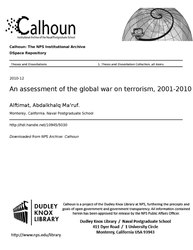File:An assessment of the global war on terrorism, 2001-2010 (IA anssessmentofglo109455030).pdf

Original file (1,275 × 1,650 pixels, file size: 628 KB, MIME type: application/pdf, 122 pages)
Captions
Captions
Summary
[edit]| An assessment of the global war on terrorism, 2001-2010
( |
||
|---|---|---|
| Author |
Alftimat, Abdalkhalq Ma'ruf. |
|
| Title |
An assessment of the global war on terrorism, 2001-2010 |
|
| Publisher |
Monterey, California. Naval Postgraduate School |
|
| Description |
There is no doubt that the 9/11 attacks constituted a new terrorism phenomena in terms of sophistication and scale of mayhem. U.S. policy makers had to consider at least three approaches in response to these attacks: the criminology or soft power approach, the war approach, and the root-causes and the battle of ideas approach. The U.S. pursued a total war on terrorism approach not only against al-Qaeda, but also against all other terrorists in world. The war approach that utilized the might of the American military against non-state actors has resulted in the loss of hundreds of thousands of lives; millions have been injured and displaced as well. Yet, despite the war approach, al-Qaeda is still posing a great threat to the Unites States and its allies. Additionally, the rate of its attacks against American targets is ever-increasing. These facts force us to reexamine the effectiveness of the war approach nine years after to its commencement. This research examines the effectiveness of the war approach using metrics other than body count. It looks at the effect of the war on al-Qaeda's organizational structure. It major finding is that the war on terrorism has forced al-Qaeda to transform its organizational structures to al-Qaeda's advantage. The war helped al-Qaeda's organization to expand horizontally, creating new organizational mergers and affiliates, as well as making room for radicalizing aspiring jihadists. The organization has changed from a mere terrorist network to a radical social movement with an ideology and a brand name that has presence in more than 70 countries. Two new strategies are necessary to fight al-Qaeda effectively. First, the U.S. needs to distinguish between al-Qaeda and all other types of Islamist activism. The war approach should be limited strictly to fighting al-Qaeda alone. Second, the U.S. could benefit from adopting a \"hybrid\" approach where national and international legal cooperation is combined with a root causes and soft-power approach to separate al-Qaeda from its potential supporters. Subjects: Strategy; Terrorists; Organization; Terrorism; Prevention |
|
| Language | English | |
| Publication date | December 2010 | |
| Current location |
IA Collections: navalpostgraduateschoollibrary; fedlink |
|
| Accession number |
anssessmentofglo109455030 |
|
| Source | ||
| Permission (Reusing this file) |
This publication is a work of the U.S. Government as defined in Title 17, United States Code, Section 101. As such, it is in the public domain, and under the provisions of Title 17, United States Code, Section 105, may not be copyrighted. | |
Licensing
[edit]| Public domainPublic domainfalsefalse |
This work is in the public domain in the United States because it is a work prepared by an officer or employee of the United States Government as part of that person’s official duties under the terms of Title 17, Chapter 1, Section 105 of the US Code.
Note: This only applies to original works of the Federal Government and not to the work of any individual U.S. state, territory, commonwealth, county, municipality, or any other subdivision. This template also does not apply to postage stamp designs published by the United States Postal Service since 1978. (See § 313.6(C)(1) of Compendium of U.S. Copyright Office Practices). It also does not apply to certain US coins; see The US Mint Terms of Use.
|
 | |
| This file has been identified as being free of known restrictions under copyright law, including all related and neighboring rights. | ||
https://creativecommons.org/publicdomain/mark/1.0/PDMCreative Commons Public Domain Mark 1.0falsefalse
File history
Click on a date/time to view the file as it appeared at that time.
| Date/Time | Thumbnail | Dimensions | User | Comment | |
|---|---|---|---|---|---|
| current | 15:36, 14 July 2020 |  | 1,275 × 1,650, 122 pages (628 KB) | Fæ (talk | contribs) | FEDLINK - United States Federal Collection anssessmentofglo109455030 (User talk:Fæ/IA books#Fork8) (batch 1993-2020 #7759) |
You cannot overwrite this file.
File usage on Commons
The following page uses this file:
Metadata
This file contains additional information such as Exif metadata which may have been added by the digital camera, scanner, or software program used to create or digitize it. If the file has been modified from its original state, some details such as the timestamp may not fully reflect those of the original file. The timestamp is only as accurate as the clock in the camera, and it may be completely wrong.
| Short title |
|
|---|---|
| Author | silva |
| Software used | PScript5.dll Version 5.2 |
| File change date and time | 07:03, 20 January 2012 |
| Date and time of digitizing | 23:41, 14 December 2010 |
| Date metadata was last modified | 07:03, 20 January 2012 |
| Conversion program | Acrobat Distiller 8.2.5 (Windows) |
| Encrypted | no |
| Page size | 612 x 792 pts (letter) |
| Version of PDF format | 1.4 |

